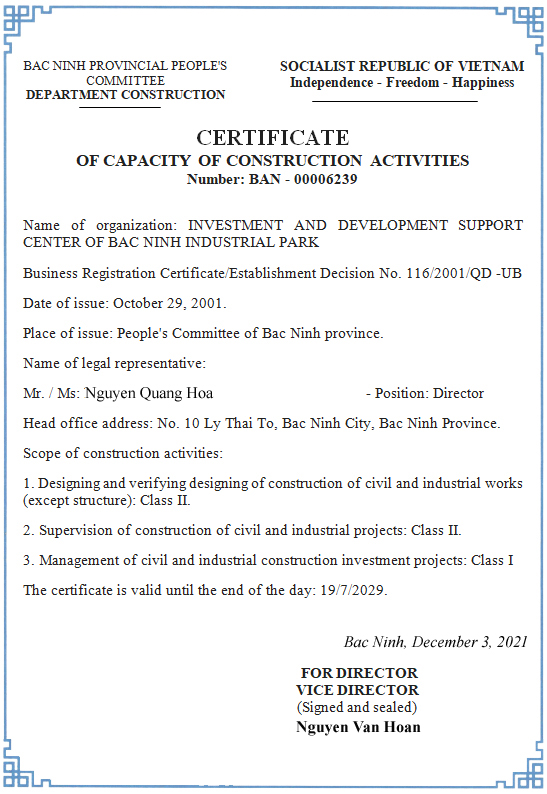
illustration
In 1997, when Bac Ninh province was re-established - it was still a purely agricultural province, the province's total product at current prices (GDRP) only reached 2,020 billion VND (equivalent to 182.6 million USD), ranked 8th out of 11 provinces and cities belong to the Red River Delta region and contribute insignificantly (0.64%) to the national GDP.
With the dynamism and high determination of the whole political system, the efforts of the business community and all classes of people, the economic scale has made a breakthrough. The period 1997-2010 was to shape the economic development model, with the focus on building synchronous infrastructure, forming concentrated industrial parks, consolidating industrial clusters of craft villages, attracting the invesment capital from economic groups of Japan, Korea, Taiwan, China, Europe, America... to build the basic. By 2010, the scale of GRDP (current price) will reach 38.7 trillion VND (equivalent to 1,984 million USD), 10.9 times higher than in 1997, accounting for 1.8% of national GDP; rank 6th out of 11 provinces and cities in the Red River Delta and in the top 20 provinces and cities in the country.
In the 2011-2021 period, on the basic of 15 years ago and with the increase of the investment capital, the production expansion of FDI enterprises, these motivated the speed up of Bac Ninh. By 2021, the scale of GRDP has increased to 227.6 trillion VND (equivalent to 9,878 million USD), nearly 5 times higher than in 2010 and 54.1 times higher in 1997; accounting for 2.71% of the national GDP, ranked 8th out of 63 provinces and cities, and 4th in the Red River Delta. This is an important mark, making Bac Ninh a spotlight in the country's economic development.
From a purely agricultural province, with agriculture accounting for a large proportion of the economic structure, thanks to the orientation to turn into an industrial province, many mechanism and policies has been applied flexibly, these has contributed to accelerating the transformation in the economic structure. In 1997, the agriculture, forestry and fishery sector accounted for the largest proportion (45%); industry and construction accounted for 23.8%; service sector accounted for 31.2%.
In
the 2001-2010 period, with the participation of FDI enterprises of large
corporations investing in industries, it has contributed to the rapid growth of
scale of the industry - construction sector and a great contribution to the
structure of the industry province's economy. By 2010, the proportion of agriculture,
forestry and fishery decrease to 9.7%; the industry - construction sector
increased to 52.6% and the service sector accounted for 30.4%; Product tax
excluding subsidies accounted for 7.3%. In the 2011-2021 period, the economic
structure continue to change in direction of increasing the proportion of
industry, decreasing the remaining two sectors. By 2021, the proportion of the
industry - construction sector accounts for the largest proportion at 77.3% and
the agriculture, forestry and fishery sector accounts for the smallest proportion
with 2.7%. While the proportion of the service sector decreased quite a lot
because of the rapid increase in the industrial scale and the impact of the
COVID-19 epidemic from 2020. Many service industries decreased deeply, so that
until 2021 the proportion of service section remains 16.1%; and the proportion
of product tax remains 3.9%.
In general, in 25 years, the economic growth speed of Bac Ninh province reaches 13.9% per year. In which, the agriculture, forestry and fishery sector increased with the lowest speed (+2.2% per year); the industry - construction sector take the lead in economic development with the rate 17.9%, the service sector also achieves growth rate of 12% per year.
The economic scale has expanded and the economic base has grown rapidly. These contribute to increase in budget revenues. Since 2011, Bac Ninh is the 13th province about self-balance and regulate the central budget (7%/year). In 2021, the total state budget revenue in Bac Ninh is estimated at 33.26 trillion VND, 168 times higher than in 1997; the average growth rate in the period 1997-2021 is 23.7% per year; the ratio of budget revenue to GRDP increased from 9.8% in 1997 to 14.6% in 2021.
With
high growth speed as well as rapid increase in economic scale, Bac Ninh not
only contributes to becoming the growth pole of the Northern and the Capital
key economic region, but also makes an important contribution to the overall
growth of Vietnam country.






